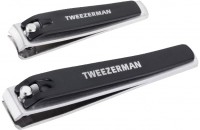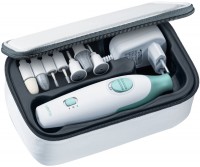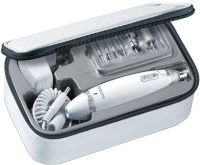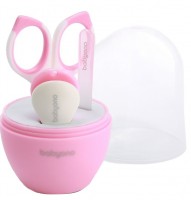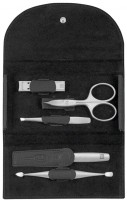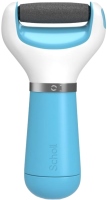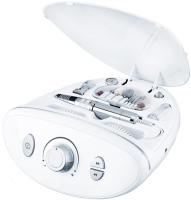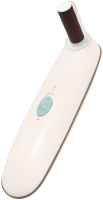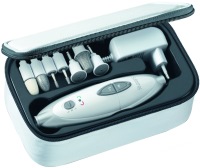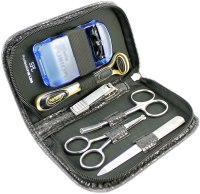Nail Care Kits Zwilling
All Nail Care Kits Advanced filters → |
You might be interested in
Articles, reviews, useful tips
All materials
TOP-5 rectifiers with ionization function
Stylers that not only help straighten hair, but also reduce the damage from exposure to high temperatures

What to give a girl?
Note to guys: variable gift ideas for girlfriends

What to give a friend?
We have selected different gift options for a girl that will suit those who love cooking, self-care and so on
Nail Care Kits: specifications, types
Type
— Manicure set. Manicure set — a set of tools that are designed to care for the nail plates and skin of the hands. Manicure involves the use of highly specialized tools / nozzles that are poorly adapted for pedicure. A classic manicure set of tools may include: small scissors, a nail file, tweezers, tongs, nippers and a cuticle spatula. Regarding the hardware (electric) manicure, the set may include: a drive, grinding and polishing nozzles, drying for nails.
— Frazier. Fraser — a device for hardware manicure / pedicure. This device consists of a control unit and a drive, in the form of an ergonomic handle. Some models are also equipped with a pedal, with which you can adjust the speed of rotation of the drive. The head of the router uses removable nozzles, the working area of which has a special abrasive coating, due to which it turns out to effectively process the nail plates and keratinized skin. The milling cutter can use many varieties of nozzles. The main nozzles can be considered cylindrical, oval and flat. In this case, the nozzles can perform both rough grinding and fine polishing. There are separate categories of nozzles for manicure and pedicure.
— Roller saw. Designed to remove old calluses, corns and other traces of keratinization of the skin on the feet. A roller file acts on the skin with a special roller, the working surface of which has...an abrasive coating. Complete with a file, 2-3 additional rollers can be supplied, and each of them can have a different roughness.
— Frazier. Fraser — a device for hardware manicure / pedicure. This device consists of a control unit and a drive, in the form of an ergonomic handle. Some models are also equipped with a pedal, with which you can adjust the speed of rotation of the drive. The head of the router uses removable nozzles, the working area of which has a special abrasive coating, due to which it turns out to effectively process the nail plates and keratinized skin. The milling cutter can use many varieties of nozzles. The main nozzles can be considered cylindrical, oval and flat. In this case, the nozzles can perform both rough grinding and fine polishing. There are separate categories of nozzles for manicure and pedicure.
— Roller saw. Designed to remove old calluses, corns and other traces of keratinization of the skin on the feet. A roller file acts on the skin with a special roller, the working surface of which has...an abrasive coating. Complete with a file, 2-3 additional rollers can be supplied, and each of them can have a different roughness.
Number of nozzles/tools
The total number of attachments or tools included in the kit.
Nozzles are referred to when it comes to an electric model, tools are indicated for instrument sets (see "Type"). In both cases, the more diverse the equipment, the more extensive the possibilities of the manicure set, the more advanced it is considered. On the other hand, this indicator significantly affects the dimensions, weight and cost, and the real need for a variety of nozzles / tools does not always arise. Therefore, when choosing, you should take into account the features of using the device: it hardly makes sense to purchase a professional set of a couple of dozen tools if you just need to keep your nails in order while traveling.
Note that in sets that include double-sided devices (for example, with a scraper on one side and a cuticle spatula on the other), each side of such a device is considered a separate tool (as it has its own application).
Nozzles are referred to when it comes to an electric model, tools are indicated for instrument sets (see "Type"). In both cases, the more diverse the equipment, the more extensive the possibilities of the manicure set, the more advanced it is considered. On the other hand, this indicator significantly affects the dimensions, weight and cost, and the real need for a variety of nozzles / tools does not always arise. Therefore, when choosing, you should take into account the features of using the device: it hardly makes sense to purchase a professional set of a couple of dozen tools if you just need to keep your nails in order while traveling.
Note that in sets that include double-sided devices (for example, with a scraper on one side and a cuticle spatula on the other), each side of such a device is considered a separate tool (as it has its own application).
Power source
The type of power used by the electric model (see "Type").
— Network. Powered by normal household sockets. This option is convenient because you do not have to monitor the condition of the battery / accumulator: the machine will work as long as there is voltage in the network, and the risk of being left without power at the most inopportune moment (for example, in the middle of the work process) is minimal. On the other hand, in the absence of sockets, such models become practically useless; in addition, the mains cable restricts mobility.
— Battery. Powered by an original branded battery that does not belong to standard sizes (see "Batteries" below), and in some models it is also non-removable. Like replaceable cells, batteries allow the machine to work regardless of the presence of outlets nearby; at the same time, in some moments this option is much more convenient. So, batteries are able to accumulate more energy, which has a positive effect on power and battery life; they are immediately supplied in the kit, which eliminates the additional hassle and cost of the purchase; and charging the battery is usually easier and cheaper than looking for fresh batteries. On the other hand, if there is a supply of batteries, they can be easily changed, while recharging takes time and a power source.
— Batteries. Powered by replaceable elements of a stand...ard size — for example, "finger" AA (other options may also be found). Such models, like battery ones, do not depend on sockets and can be used autonomously. The replaceable cells themselves can be produced both in the form of disposable batteries and in the form of rechargeable batteries. At the same time, both the first and second options make it easy to change dead batteries for fresh ones (the main thing is to stock up on them in advance). Of the shortcomings, it is worth noting the relatively low capacity, as well as the need for additional costs — either for the regular purchase of fresh batteries, or for rather expensive batteries. In addition, there are many batteries on the market, varying in price and performance, and the actual operating time is highly dependent on the quality of the batteries/accumulators used.
— Network / battery. Models that can work both from the network and from their own battery. The features of both types of power are described above, and their combination allows you to combine the advantages of both options and makes the machine very versatile: if you have an outlet, you can use it, and if there is no network nearby, run on battery power. The main disadvantage of such models is a slightly higher price than devices with one type of power supply.
— Network. Powered by normal household sockets. This option is convenient because you do not have to monitor the condition of the battery / accumulator: the machine will work as long as there is voltage in the network, and the risk of being left without power at the most inopportune moment (for example, in the middle of the work process) is minimal. On the other hand, in the absence of sockets, such models become practically useless; in addition, the mains cable restricts mobility.
— Battery. Powered by an original branded battery that does not belong to standard sizes (see "Batteries" below), and in some models it is also non-removable. Like replaceable cells, batteries allow the machine to work regardless of the presence of outlets nearby; at the same time, in some moments this option is much more convenient. So, batteries are able to accumulate more energy, which has a positive effect on power and battery life; they are immediately supplied in the kit, which eliminates the additional hassle and cost of the purchase; and charging the battery is usually easier and cheaper than looking for fresh batteries. On the other hand, if there is a supply of batteries, they can be easily changed, while recharging takes time and a power source.
— Batteries. Powered by replaceable elements of a stand...ard size — for example, "finger" AA (other options may also be found). Such models, like battery ones, do not depend on sockets and can be used autonomously. The replaceable cells themselves can be produced both in the form of disposable batteries and in the form of rechargeable batteries. At the same time, both the first and second options make it easy to change dead batteries for fresh ones (the main thing is to stock up on them in advance). Of the shortcomings, it is worth noting the relatively low capacity, as well as the need for additional costs — either for the regular purchase of fresh batteries, or for rather expensive batteries. In addition, there are many batteries on the market, varying in price and performance, and the actual operating time is highly dependent on the quality of the batteries/accumulators used.
— Network / battery. Models that can work both from the network and from their own battery. The features of both types of power are described above, and their combination allows you to combine the advantages of both options and makes the machine very versatile: if you have an outlet, you can use it, and if there is no network nearby, run on battery power. The main disadvantage of such models is a slightly higher price than devices with one type of power supply.
Maximum operating time
The longest time that a self-powered electric kit (see "Type") (see above) can operate without changing batteries or recharging the battery. The higher this indicator, the more convenient the device will be in operation, the less often you will have to be distracted by its maintenance. At the same time, note that in the characteristics, the operating time is given, usually, for perfect conditions: with a minimum load on the nozzle (or even at idle), using high-quality batteries, etc. The actual time of continuous operation is highly dependent on the characteristics of the mode of use and can be noticeably less than the claimed one.
Sharpening
— Mechanical. Mechanical sharpening of the tool is carried out on an automated production line, without the direct participation of a person.
— Manual. Manual sharpening is typical for professional tools. The hand-sharpened blades have a long service life. There are several types of manual sharpening: mechanical and laser. For mechanical sharpening, traditional abrasive tools are used: grinding wheels and whetstones, emery, felt, Goya paste, etc. With laser sharpening, a special device is used that acts on a sharp edge with a high-temperature beam.
— Manual. Manual sharpening is typical for professional tools. The hand-sharpened blades have a long service life. There are several types of manual sharpening: mechanical and laser. For mechanical sharpening, traditional abrasive tools are used: grinding wheels and whetstones, emery, felt, Goya paste, etc. With laser sharpening, a special device is used that acts on a sharp edge with a high-temperature beam.
Application
The type of procedures for which the set is intended.
— Manicure. A manicure is a procedure for caring for the hands, primarily nails. Such work is considered more “fine” than a pedicure, due to the smaller size and thickness of the nails, which accordingly affects the features of the tool. In addition, "pure manicure" kits do not include skin care devices — such care is carried out by other means (creams, scrubs, etc.); the functions of the tools are limited to the processing of the cuticle and the removal of burrs.
— Pedicure. A pedicure includes toenail treatments. These nails are thicker and harder than those on the hands, so they require a specialized tool. In addition, some foot care tasks, such as callus removal, also require the use of tools.
Note that many modern kits are universal and include devices for both manicure and pedicure. Such versatility is especially common among electric models (see "Type").
— Manicure. A manicure is a procedure for caring for the hands, primarily nails. Such work is considered more “fine” than a pedicure, due to the smaller size and thickness of the nails, which accordingly affects the features of the tool. In addition, "pure manicure" kits do not include skin care devices — such care is carried out by other means (creams, scrubs, etc.); the functions of the tools are limited to the processing of the cuticle and the removal of burrs.
— Pedicure. A pedicure includes toenail treatments. These nails are thicker and harder than those on the hands, so they require a specialized tool. In addition, some foot care tasks, such as callus removal, also require the use of tools.
Note that many modern kits are universal and include devices for both manicure and pedicure. Such versatility is especially common among electric models (see "Type").
Power
The power of the device is related to both its performance and consumption. But in general, high power characterizes more features and improved typing performance.
So, models with a power of 3-15 W are intended for the most part for individual use. Manicure sets of this class are not designed to work in salons where there is a large flow of users. Low power devices are only suitable for processing natural nails.
Milling cutters with a power of 15-25 W can be classified as semi-professional. Manicure sets of this class can be safely used both at home and in a beauty salon, and the power of the product is quite enough for comfortable processing of both natural and false nails.
Milling cutters with a power of 25-50 W and more belong to the professional class. Such devices are designed for the most automated hardware manicure and pedicure. Milling cutters of this class allow you to quickly and safely serve a large flow of users. In addition, high-power manicure sets often additionally boast advanced functionality.
Number of speeds
The number of speeds at which the electric model can operate (see "Type"). For different nozzles, different speeds are considered optimal, and even for the same one, several speed modes can be used, depending on the desired processing intensity. Thus, the more speeds — the wider the capabilities of the device, the more accurately you can choose the best option depending on the situation. For maximum accuracy, however, it is better to select a model with smooth adjustment (see below), however, if this moment is not critical, fixed settings will still be more convenient.
Maximum revolutions
The maximum speed of rotation of the working nozzle of the set. The higher the rotation speed, the more performant the effect will be. But more is not always better, especially for sensitive people with delicate skin.
Usually, models with a maximum speed of up to 5,000 rpm are more suitable for processing natural nail tissue and cornea. Cutters with a maximum speed of over 5,000 rpm are already capable of processing both natural nails and false nails made of acrylic and other synthetic materials.
Professional grade manicure sets can have a maximum rotation speed of up to 30,000 — 45,000 rpm and even more.
Smooth speed control
The ability to smoothly change the speed of rotation of the nozzle in the electric model (see "Type"). This method of adjustment is considered the most accurate, because. it does not imply specific fixed speed values and allows you to choose almost any option from the minimum to the maximum. At the same time, smooth tuning requires some skills and can create some inconvenience for inexperienced users.
Reverse
The presence in the electrical model (see "Type") of the ability to change the direction of rotation to the opposite.
Most of the procedures carried out by electric machines imply a certain direction of movement of the nozzle relative to the nail being processed. And since the position of the nails themselves can also be different (for example, when processing different hands), the direction of rotation has to be changed. This possibility is provided due to the reverse — without it, the machine itself would have to be moved, and this, usually, is inconvenient (and in some situations it is impossible at all).
Most of the procedures carried out by electric machines imply a certain direction of movement of the nozzle relative to the nail being processed. And since the position of the nails themselves can also be different (for example, when processing different hands), the direction of rotation has to be changed. This possibility is provided due to the reverse — without it, the machine itself would have to be moved, and this, usually, is inconvenient (and in some situations it is impossible at all).
Backlight
The presence of a lighting system in the design of an electrical device (see "Type"). Such a system provides additional illumination at the treatment site, which allows successful procedures to be carried out regardless of the presence of sufficiently bright external lighting. Just keep in mind that the backlight also requires electricity; this is not a problem when using mains power, however, when using a battery/accumulator, it can significantly reduce battery life.
Dryer for nails
The presence in the manicure set of the function of drying nails.
Drying is usually found in electric models (see "Type"). It is most often implemented through a built-in fan that provides airflow to the nails; the fan can be placed inside the stand or be made as a separate nozzle. Another drying option is a UV lamp. However, anyway, this function is intended to speed up the drying of the varnish applied to the nails. However it must be borne in mind that for some varnishes, a fan is considered optimal, and for others, a UV lamp. Therefore, when choosing, it is worth specifying which option is implemented in the manicure set and whether it is suitable for the varnishes used.
Drying is usually found in electric models (see "Type"). It is most often implemented through a built-in fan that provides airflow to the nails; the fan can be placed inside the stand or be made as a separate nozzle. Another drying option is a UV lamp. However, anyway, this function is intended to speed up the drying of the varnish applied to the nails. However it must be borne in mind that for some varnishes, a fan is considered optimal, and for others, a UV lamp. Therefore, when choosing, it is worth specifying which option is implemented in the manicure set and whether it is suitable for the varnishes used.
Hand bath
The presence of a bath for hands in the delivery set of a manicure set.
Many nail care procedures are best done after soaking and steaming: nails and skin become soft, which not only makes work easier, but also reduces discomfort. Baths are designed for such steaming. They are also sold separately, but most often it is easier to immediately buy a manicure set with a bath in the kit.
Many nail care procedures are best done after soaking and steaming: nails and skin become soft, which not only makes work easier, but also reduces discomfort. Baths are designed for such steaming. They are also sold separately, but most often it is easier to immediately buy a manicure set with a bath in the kit.
Nozzles
Types of nozzles supplied with the manicure set. Nozzles are supplied with electric models only (see "Type").
— Polishing cone. Conical nozzle designed for polishing — i.e. processing the surface of the nails in order to give them shine and a neat look. Has a small notch or felt coating. The shape of the nozzle allows you to process both individual small areas and large areas — in the first case, a pointed tip is used, in the second — the straight part of the nozzle is closer to the base.
— Cone for grinding. In this case, it means a conical nozzle designed to treat dry and rough skin around the nails on the hands, as well as cleaning ingrown nails. It is usually small in size, which is why it may also be called a "thin cone nozzle".
— Cone for filing. Conical filing heads have a non-standard shape — they do not taper towards the end, like most cones, but, on the contrary, expand. This allows you to conveniently file your nails, including in hard-to-reach places. One of the most popular materials for such nozzles is corundum.
— Oval for grinding. A small oval-shaped nozzle used for grinding the lateral ridges and the area along the cuticle.
— Cylindrical for grinding. This attachment is designed to gently remove rough skin around the nails.
— Spherical for grinding. The s...pherical working part of this nozzle has a small shape, so it is convenient for delicate treatment of nails and cuticle removal on hands and feet.
— Polishing disc. A disc nozzle with a fine notch or felt coating, designed for fine polishing of nails — both the nail plate itself and the edges after filing. It has a fairly large size, due to which it captures a larger area during operation than a cone.
— Grinding disc. The main purpose of all grinding discs is the treatment of rough skin and calluses — primarily on the legs, but there are nozzles for the hands. Note that discs can vary in size (larger for legs, smaller for hands) and processing intensity (for coarse and soft grinding).
— Cutting disc. A disc with a rough coating — usually corundum — designed for filing nails and giving them the desired shape. Especially such a nozzle is useful for large and thick nails. Discs can be designed for both fingers and toes; the second variety is noticeably larger.
— To lift the cuticles. A nozzle in the form of a characteristic spatula that allows you to lift the cuticle for accurate cutting (usually this is done after softening in the bath or using a special tool). One of the few nozzles that does not rotate during operation.
— To remove calluses. A specialized nozzle for removing corns, usually on the legs. It can have a different shape and design: in specialized machines for working with corns, this is usually an abrasive roller, in multi-purpose models — a cone.
— Cleaning brush. A device for gently cleaning the surface of the nail from dirt. Thanks to soft bristles, it does not have an abrasive effect and does not injure the nail and the skin around it.
— Massager. Nozzles of this type, usually, are intended for facial massage, however, some of them may have other specializations.
Note that this is not the whole list — in some models, other attachments may be provided, for example, a foam rubber sponge or an eyelash curler.
— Polishing cone. Conical nozzle designed for polishing — i.e. processing the surface of the nails in order to give them shine and a neat look. Has a small notch or felt coating. The shape of the nozzle allows you to process both individual small areas and large areas — in the first case, a pointed tip is used, in the second — the straight part of the nozzle is closer to the base.
— Cone for grinding. In this case, it means a conical nozzle designed to treat dry and rough skin around the nails on the hands, as well as cleaning ingrown nails. It is usually small in size, which is why it may also be called a "thin cone nozzle".
— Cone for filing. Conical filing heads have a non-standard shape — they do not taper towards the end, like most cones, but, on the contrary, expand. This allows you to conveniently file your nails, including in hard-to-reach places. One of the most popular materials for such nozzles is corundum.
— Oval for grinding. A small oval-shaped nozzle used for grinding the lateral ridges and the area along the cuticle.
— Cylindrical for grinding. This attachment is designed to gently remove rough skin around the nails.
— Spherical for grinding. The s...pherical working part of this nozzle has a small shape, so it is convenient for delicate treatment of nails and cuticle removal on hands and feet.
— Polishing disc. A disc nozzle with a fine notch or felt coating, designed for fine polishing of nails — both the nail plate itself and the edges after filing. It has a fairly large size, due to which it captures a larger area during operation than a cone.
— Grinding disc. The main purpose of all grinding discs is the treatment of rough skin and calluses — primarily on the legs, but there are nozzles for the hands. Note that discs can vary in size (larger for legs, smaller for hands) and processing intensity (for coarse and soft grinding).
— Cutting disc. A disc with a rough coating — usually corundum — designed for filing nails and giving them the desired shape. Especially such a nozzle is useful for large and thick nails. Discs can be designed for both fingers and toes; the second variety is noticeably larger.
— To lift the cuticles. A nozzle in the form of a characteristic spatula that allows you to lift the cuticle for accurate cutting (usually this is done after softening in the bath or using a special tool). One of the few nozzles that does not rotate during operation.
— To remove calluses. A specialized nozzle for removing corns, usually on the legs. It can have a different shape and design: in specialized machines for working with corns, this is usually an abrasive roller, in multi-purpose models — a cone.
— Cleaning brush. A device for gently cleaning the surface of the nail from dirt. Thanks to soft bristles, it does not have an abrasive effect and does not injure the nail and the skin around it.
— Massager. Nozzles of this type, usually, are intended for facial massage, however, some of them may have other specializations.
Note that this is not the whole list — in some models, other attachments may be provided, for example, a foam rubber sponge or an eyelash curler.
Instruments
Tools included in the manicure set. In this case, tools are meant to be hand-held devices that are not designed to be used as nozzles and do not require a drive from an electric motor for operation. It is from them that sets of devices consist (see "Type"), however, electric models can also be equipped with tools.
— Scissors. The main purpose of manicure scissors is to cut off overgrown nails — in cases where the length of the excess part is large and there is no point in cutting it off with a nail file. This procedure, however, requires some caution, because. the risk of minor injury when using this tool is higher than when working with tweezers (see below); at the same time, scissors allow you to cut the nail more accurately. In addition, they can be used as a deburring tool.
— Nail file (glass). The set includes a nail file made of tempered glass and equipped with a special rough surface. It is believed that it is these nail files that most carefully affect the nail, do not exfoliate the edges. First of all, they are recommended for use by those who have a soft nail plate. Works equally well on both artificial and natural nails. In addition, after the procedure of washing or treatment with a disinfectant solution, the glass nail file does not lose its qualities. But the material itself, from which the nail file is made, is quite fragile, it can be easily broken.
— Nail f...ile (metal). It implies the presence of classic metal nail files, which can be called a universal and reliable solution for nail care. Usually, they all have a classic shape and a plastic handle, are relatively inexpensive and at the same time are very durable. The vast majority of these nail files are coarse-grained, rather rough in work, which can lead to injury of too soft or thin nails. Primarily recommended for artificial or thick nails, when used for natural nail care increases the risk of delamination.
— Nail file (pumice). It implies the presence of a special nail file made of pressed aluminium oxide with porcelain. First of all, it is designed to remove cuticles, various roughness on the skin and create a European manicure. Allows you to completely remove dry and roughened skin of the nail fold. It can be used for both "wet" and "dry" types of manicure, but the first option is considered more preferable. One of the main drawbacks of the method is the length of the removal procedure itself.
— Nippers. Two types of nippers can be provided in manicure sets: for cutting nails and for cutting cuticles. All such tools outwardly resemble small side cutters with a specific shape of the working blades (halves on which the cutting edges are located); the specific shape and size of these paintings depends on the specialization. Nail clippers have a similar function to the scissors described above, but they provide more cutting force. On the one hand, this requires special care, on the other hand, it allows you to work with thick or ingrown nails, which is especially useful for pedicures. Cuticle nippers are also called cuticle nippers. They can be used for both manicure and pedicure; The "foot" variety of skins is distinguished by a longer length of the canvases.
— Tweezers (knipser). Tweezers of a characteristic shape with short and narrow sharpened blades (which are also slightly curved in order to optimally match the shape of the nail), as well as a special lever (usually folding), when pressed, the blades close. The purpose of clippers is similar to scissors — cutting nails; at the same time, such tools work faster and are considered more secure, because. they do not have sharp protruding parts, and it is almost impossible to cut yourself with the blades (although some care must still be taken when cutting). On the other hand, tweezers are less accurate and less suitable for fine work. Therefore, their main purpose is considered to be pedicure and “rough” processing of fingernails (and even then the latter option is preferred mainly by men who are not inclined to pay as much attention to nails as women).
— Cuticle trimmer. A tool for gently cutting the cuticle, usually in the form of a small, sharp, V-shaped blade. Usually, this requires lifting the cuticle, therefore, along with the trimmer, the corresponding spatula is included in the set (see below), and in some cases both of these tools are placed on the same handle, on both sides.
— Cuticle spatula. A small spatula designed to gently lift the cuticle (pre-softened by a bath or applying a special tool). After that, the cuticle can be cut with a trimmer or wire cutters (see above). Also, this tool is sometimes called a "pusher". The paddle can be part of a reversible fixture and can be combined with a trimmer or scraper (see below).
— Chabert. A scraper in this case means a tool in the form of a small pointed hatchet, designed to clean the space under the free edge of the nail, as well as its side parts. It is rarely performed as a separate device, most often combined with a cuticle spatula (see above).
— Pusher (hoof). The working part of this tool has the form of a cylinder cut obliquely, so that a characteristic protrusion is obtained (similar in shape to a hoof). Its purpose is similar to the cuticle pusher (see above), however, the pusher is often made of softer materials (in particular, rubber), which provides the most delicate cuticle lift.
— Tweezers. Cosmetic tweezers are used primarily for plucking hairs; it can be hairs on the arms or legs, but most often such a tool is used to thin the eyebrows.
In addition to the tools described above, there may be others in the kit — for example, a machine for cutting off rough skin during a pedicure, a UNO spoon for cleaning pores, etc.
— Scissors. The main purpose of manicure scissors is to cut off overgrown nails — in cases where the length of the excess part is large and there is no point in cutting it off with a nail file. This procedure, however, requires some caution, because. the risk of minor injury when using this tool is higher than when working with tweezers (see below); at the same time, scissors allow you to cut the nail more accurately. In addition, they can be used as a deburring tool.
— Nail file (glass). The set includes a nail file made of tempered glass and equipped with a special rough surface. It is believed that it is these nail files that most carefully affect the nail, do not exfoliate the edges. First of all, they are recommended for use by those who have a soft nail plate. Works equally well on both artificial and natural nails. In addition, after the procedure of washing or treatment with a disinfectant solution, the glass nail file does not lose its qualities. But the material itself, from which the nail file is made, is quite fragile, it can be easily broken.
— Nail f...ile (metal). It implies the presence of classic metal nail files, which can be called a universal and reliable solution for nail care. Usually, they all have a classic shape and a plastic handle, are relatively inexpensive and at the same time are very durable. The vast majority of these nail files are coarse-grained, rather rough in work, which can lead to injury of too soft or thin nails. Primarily recommended for artificial or thick nails, when used for natural nail care increases the risk of delamination.
— Nail file (pumice). It implies the presence of a special nail file made of pressed aluminium oxide with porcelain. First of all, it is designed to remove cuticles, various roughness on the skin and create a European manicure. Allows you to completely remove dry and roughened skin of the nail fold. It can be used for both "wet" and "dry" types of manicure, but the first option is considered more preferable. One of the main drawbacks of the method is the length of the removal procedure itself.
— Nippers. Two types of nippers can be provided in manicure sets: for cutting nails and for cutting cuticles. All such tools outwardly resemble small side cutters with a specific shape of the working blades (halves on which the cutting edges are located); the specific shape and size of these paintings depends on the specialization. Nail clippers have a similar function to the scissors described above, but they provide more cutting force. On the one hand, this requires special care, on the other hand, it allows you to work with thick or ingrown nails, which is especially useful for pedicures. Cuticle nippers are also called cuticle nippers. They can be used for both manicure and pedicure; The "foot" variety of skins is distinguished by a longer length of the canvases.
— Tweezers (knipser). Tweezers of a characteristic shape with short and narrow sharpened blades (which are also slightly curved in order to optimally match the shape of the nail), as well as a special lever (usually folding), when pressed, the blades close. The purpose of clippers is similar to scissors — cutting nails; at the same time, such tools work faster and are considered more secure, because. they do not have sharp protruding parts, and it is almost impossible to cut yourself with the blades (although some care must still be taken when cutting). On the other hand, tweezers are less accurate and less suitable for fine work. Therefore, their main purpose is considered to be pedicure and “rough” processing of fingernails (and even then the latter option is preferred mainly by men who are not inclined to pay as much attention to nails as women).
— Cuticle trimmer. A tool for gently cutting the cuticle, usually in the form of a small, sharp, V-shaped blade. Usually, this requires lifting the cuticle, therefore, along with the trimmer, the corresponding spatula is included in the set (see below), and in some cases both of these tools are placed on the same handle, on both sides.
— Cuticle spatula. A small spatula designed to gently lift the cuticle (pre-softened by a bath or applying a special tool). After that, the cuticle can be cut with a trimmer or wire cutters (see above). Also, this tool is sometimes called a "pusher". The paddle can be part of a reversible fixture and can be combined with a trimmer or scraper (see below).
— Chabert. A scraper in this case means a tool in the form of a small pointed hatchet, designed to clean the space under the free edge of the nail, as well as its side parts. It is rarely performed as a separate device, most often combined with a cuticle spatula (see above).
— Pusher (hoof). The working part of this tool has the form of a cylinder cut obliquely, so that a characteristic protrusion is obtained (similar in shape to a hoof). Its purpose is similar to the cuticle pusher (see above), however, the pusher is often made of softer materials (in particular, rubber), which provides the most delicate cuticle lift.
— Tweezers. Cosmetic tweezers are used primarily for plucking hairs; it can be hairs on the arms or legs, but most often such a tool is used to thin the eyebrows.
In addition to the tools described above, there may be others in the kit — for example, a machine for cutting off rough skin during a pedicure, a UNO spoon for cleaning pores, etc.
Shaver
The presence of a shaving machine in the delivery set of a manicure set. Usually, this feature is typical for men's kits (see "Intended use") — accordingly, the complete machine is intended for shaving facial hair.
The model of the machine may be different, depending on the specific set — however, in most cases they are reusable, and additional equipment includes spare blades. Also note that complete machines most often do not differ from conventional ones sold separately — this means that, if desired, the owner can store and carry another razor in a set.
The model of the machine may be different, depending on the specific set — however, in most cases they are reusable, and additional equipment includes spare blades. Also note that complete machines most often do not differ from conventional ones sold separately — this means that, if desired, the owner can store and carry another razor in a set.
Mirror
The presence of a mirror in the delivery set of a manicure set.
Such a mirror, usually, is built into the lid of a case or other similar surface (for example, covering a compartment for drying nails). For a manicure or pedicure, usually, it is not required, but when applying makeup, it can be very useful — especially in situations where there are no other mirrors nearby.
Such a mirror, usually, is built into the lid of a case or other similar surface (for example, covering a compartment for drying nails). For a manicure or pedicure, usually, it is not required, but when applying makeup, it can be very useful — especially in situations where there are no other mirrors nearby.
Cover/case
The presence of a cover or case in the delivery set of a manicure set. The main difference between these devices is in the materials: the covers are made soft, the cases are hard. In addition, for a number of reasons, the first option is more popular among instrument kits, the second — among electric models (see "Type"). However, the purpose of covers and cases is identical, so in our catalog they are combined into one item. But this purpose is to ensure ease of storage and transportation: each tool or nozzle is placed in its “seat” inside the case / case, which minimizes the likelihood of loss or damage in contact with foreign objects.
Note that such equipment is practically mandatory for modern manicure sets of any type; options without covers / cases are practically not found.
Note that such equipment is practically mandatory for modern manicure sets of any type; options without covers / cases are practically not found.
Dimensions (set)
General dimensions of the set when folded. Since most models are equipped with covers or cases (see above), in fact, the dimensions of the case / case are usually indicated at this point — tools and attachments placed inside usually do not protrude outward.
Pay attention to these data if you plan to often carry the kit with you or take it on trips.
Pay attention to these data if you plan to often carry the kit with you or take it on trips.

